Summary
Pycnogonum litorale lives in an interstitial system, of the mussel zone on the embankment of the Jadebusen. Hard substrate, high humidity at low tide, sufficient Metridium senile as food, and active currents together with protection from drifting, constitute favourable conditions for this pycnogonid.
Prior to laying egg in February, the male remains in a riding position upon the female for approximately 24 days. Under artificial short-day conditions the riding position may also be assumed outside of the reproductive period. The eggs are transported to the ovigers of the male by trunk movements of both partners. At 12°C the larvae hatch about 41–46 days after egg-laying. No larvae hatched from eggs laid during summer at 19°C.
The larvae live endoparasitically in Hydrozoa for about 1/2 year. Following metamorphosis, the freeliving juvenile phase lasts barely a year. The maturation moult normally takes place in the summer of the second year, the reproductive period beginning about 6 months later, in winter.
Zusammenfassung
Am Leitdamm des Jadebusens lebt Pycnogonum litorale im Lückensystem des Miesmuschelbesatzes. Dieser bietet mit hartem Untergrund, hoher Feuchtigkeit bei Niedrigwasser, genügend Actinien als Nahrung und guter Durchströmung bei gleichzeitigem Schutz vor Vertragung—offensichtlich günstige Lebensbedingungen für Pycnogonum litorale.
Der Eiablage im Februar geht eine Reiterstellung des Männchens auf dem Weibchen von durchschnittlich 24 Tagen voraus. Unter künstlichen Kurztagbedingungen kann diese Reiterstellung auch außerhalb der Fortpflanzungsperiode eingenommen werden. Die Eier werden durch Rumpfbewegungen beider Partner zu den Ovigeren des Männchens bewegt. Bei 12°C schlüpfen die Larven etwa 41 bis 46 Tage nach der Eiablage aus, bei 19°C, im Sommer, schlüpften keine Larven.
Im Jadebusen leben die Larven etwa 1/2 Jahn endoparasitisch in Hydrozoen. Die an die Metamorphose anschließende juvenile Phase, in der die Tiere frei leben, dauert ein knappes Jahr, die Reifehäutung erfolgt normalerweise im Sommer des zweiten Jahres, die Fortpflanzungsperiode etwa 6 Monate später, im Winter.
Similar content being viewed by others
Literatur
Dogiel, V.: Embryologische Studien an Pantopoden. Z. wiss. Zool. 107, 629–662 (1913).
Dohrn, A.: Die Pantopoden des Golfes von Neapel. Fauna und Flora des Golfes von Neapel. Leipzig 1881.
Helfer, H.: Pantopoda. Handbuch der Zoologie (Hrsg. Kückenthal-Krumbach). Berlin u. Leipzig 1932.
Helfer, H.: Schlottke, F.: Pantopoda. Bronns Klassen und Ordnungen des Tierreiches. Leipzig 1935.
Lotz, G.: Nahrungsaufnahme und Beutefang bei einem Pantopoden, Anoplodactylus Kroyer. Oecologia (Berl.) 1, 171–175 (1968).
— Bückmann, D.: Die Häutungen und die Exuvie von Pycnogonum litorale (Ström) (Pantopoda). Zool. Jb., Abt. Anat. u. Ontog. 85, 529–536 (1968).
Meyer, K. E., Bückmann, D.: Die Häutungen des Pantopoden Pycnogonum litorale (Ström). Verh. dtsch. zool. Ges. 604–608 (1962).
Prell, H.: Beiträge zur Kenntnis der Lebensweise einiger Pantopoden. Bergens Museum Aarborg 1–29 (1910).
Schmidt, H. W.: Die Beeinflussung der Häutungen von Pycnogonum litorale (Ström) durch exogene und endogene Faktoren. Oecologia (Berl.) 7, 249–261 (1971).
Author information
Authors and Affiliations
Additional information
Mit Unterstützung der Deutschen Forschungsgemeinschaft.
Rights and permissions
About this article
Cite this article
Schmidt, HW., Bückmann, D. Beobachtungen zur Lebensweise von Pycnogonum litorale (Ström) (Pantopoda). Oecologia 7, 242–248 (1971). https://doi.org/10.1007/BF00345214
Received:
Issue Date:
DOI: https://doi.org/10.1007/BF00345214



